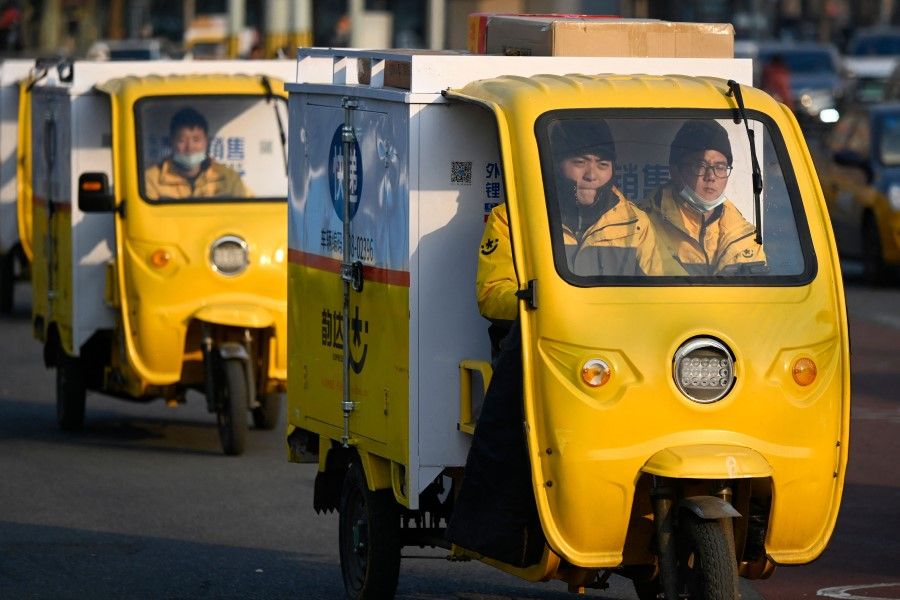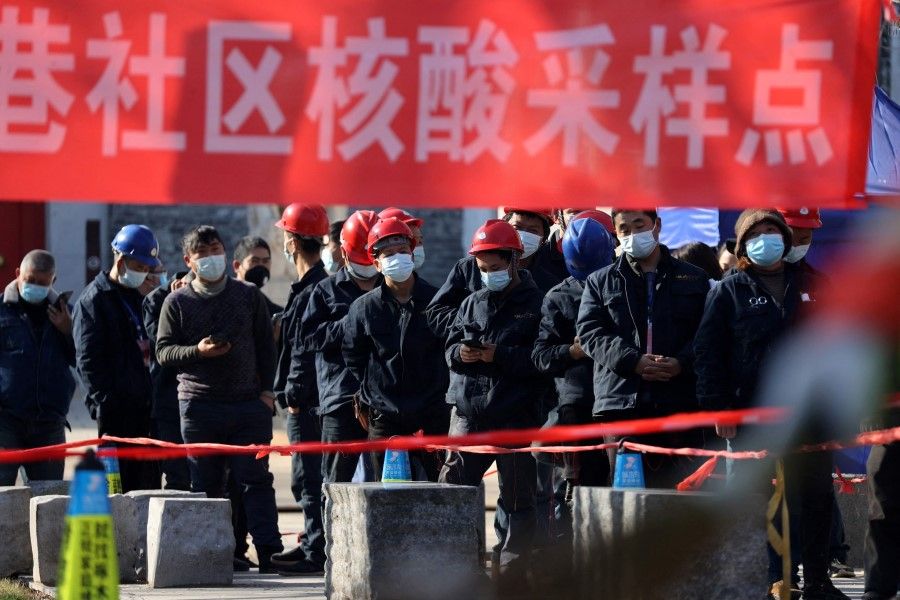200 million Chinese are in flexible employment. Is this their choice?

The phrase "China's flexibly employed reaches 200 million" became one of the top searches on Weibo in February. In stark contrast to the mild wording in state media reports, Chinese netizens have expressed their sharply worded doubts.
This begs the question, behind this new concept of "flexible employment" (灵活就业), how many people are leading an enviable life of "not working", and how many are living paycheck to paycheck?
Public opinion vs media portrayal
The foreign edition of People's Daily on 9 February reported that according to China's National Bureau of Statistics, there were 200 million people in China who were employed under flexible work arrangements as of the end of 2021. Of these, over 1.6 million were in the livestreaming and related sectors, nearly three times more than in 2020.
The report included interviews with a visual effects producer who graduated five years ago, and a geologist turned popular science streamer. They shared how flexible employment gives them full reins to develop their personal strengths and interests by building a platform to showcase their abilities. They can explore different career paths and find new ways to innovate and create through their side hustle, while earning a sizeable income in addition to their day job.
Overseas netizens also commented on the situation.
"Online work is popular among young people."
"The platform economy and shared economy are thriving and incubating rich forms of work, and the flexible economy has become a new career choice for today's young people."
Shanghai news outlet eastday.com described the phenomenon as "entrepreneurship by the masses, innovation by the multitude".
"What's crazy flexible is the way employment rates are calculated." - a Chinese netizen

However, Chinese netizens do not completely agree with the state media's enthusiasm and have raised many doubts about flexible employment.
"It's just living from hand to mouth, and yet they make it sound so inspiring!"
"Does everything have to be described positively? Will they die if there's no hypocrisy or cover up?"
"They make being unemployed and doing odd jobs sound so refreshing and unconventional."
"What's crazy flexible is the way employment rates are calculated."
"It's like celebrating death, and they actually say young people enjoy online work."
With netizens firing on all cylinders, the National Business Daily posted a notice under the comments section of its report on Weibo that inappropriate comments would be removed. Out of over 1,000 comments, only very few were visible.
Defining 'flexible employment'
Netizens' doubts are not without reason. First, the articles do not clearly define flexible employment. And given that 200 million people constitute around 15% of China's total population, more concrete figures should be published about this large demography.
For example, aside from the 1.6 million livestreamers, how many are product description writers, delivery riders, construction workers or small business owners? How are they distributed across sectors and what is their income like?

Some bloggers have suggested collating monthly income by listing the number of people in various income brackets, for a clearer picture of the flexible economy.
Second, some organisations in China have calculated and analysed statistics on flexible employment. For example, the School of Labour and Human Resources at Renmin University of China has released its annual blue book on hiring flexible workers in 2021 and 2022. While the report is from the perspective of employers and focuses on hiring workers on flexi-terms, it gives a glimpse into the situation of those employed under these terms.
...the flexibly employed are mostly general workers doing odd jobs. Their work is not stable, and compared with the formally employed, they are less likely to have sufficient legal protection...
The report defines those flexibly employed as workers who engage in employment outside of the standard employment relationship to receive flexible remuneration. The flexibility relates to working hours, income, work location, insurance, benefits and employment relationship, which allows more freedom than the traditional employment model.
The 2022 report found that the hiring of workers on flexi-terms was mostly focused on "general workers" in construction, service, sanitation, security, cleaning and housekeeping services.
According to preliminary data gathered by the research group, 45.62% of companies hired workers on flexi-terms mainly as general workers, with 18.22% as IT and other technical workers; 11.54% in sales, promotion and credit collection; 7.23% in customer service, checking and tagging; and 7.09% as skilled blue-collar workers.

Hence, the flexibly employed are mostly general workers doing odd jobs. Their work is not stable, and compared with the formally employed, they are less likely to have sufficient legal protection. They would also not have sufficient social security in the case of any labour disputes.
Furthermore, while China's labour laws stipulate equal pay for the same job, those flexibly employed still face problems such as pay inequality or being paid below the legal standard.
...flexible employment is a desperate choice for someone in a difficult employment situation and usually not a deliberate decision.
The only option in tough times
As the epidemic situation becomes normalised in China, many new business models have emerged in the service sector, providing rich grounds for hiring workers on flexi-terms. However, positions for flexible workers in the platform economy and shared economy such as video production, online streaming and product description writers accounted for just 0.83% of the research data.
Notably, for 52.36% of those flexibly employed, the main reason for choosing flexible work is high economic pressure at home, while 45.2% wanted to gain work experience, and 34.73% had no other work opportunities.
Therefore, the doubts of netizens and bloggers are justified. Many believe that in most circumstances, flexible employment is a desperate choice for someone in a difficult employment situation and usually not a deliberate decision. However, the media selected a few success stories, portrayed frustration and hardship in glowing terms and created a sense of well-being.
Former Global Times editor-in-chief Hu Xijin said, "The figure of 200 million cannot be trumpeted as an achievement. It is a fact. The frustration and hardship would definitely outweigh the glamour and joy."

Do official figures reflect reality?
The wave of debate has also thrown up another discussion: how accurately do China's official statistics reflect the actual situation?
Since the pandemic, the economies of the US and Europe have been significantly hit after the tightening of the epidemic measures, and unemployment rates soared. US unemployment spiked to 14.7% in April 2020, the highest since the Great Depression in the 1930s, gradually falling to 4.0% in January this year. As for China, despite implementing the strictest epidemic measures in the world, its unemployment rate stayed below 5%.
In terms of unemployment rate calculation, China has two sets of unemployment statistics based on different data sources. First, the registered urban unemployment rate, which clearly underestimates the real number as it only accounts for those who register with government agencies and fit the unemployment criteria; and second, the surveyed urban unemployment rate, which also does not properly account for unemployment among migrant workers.
There have always been concerns about the accuracy and reliability of China's statistics, inviting criticisms even from people within the system. The Central Economic Work Conference held in Beijing in December last year addressed that the Chinese economy is facing the triple pressures of "shrinking demand, supply shocks and weakening expectations".
...official figures show an increase in the number of companies and other market entities during the pandemic, but in fact, many of them are stagnant because of difficulties in operations and deregistration.

However, Bloomberg reported that during an online event after the conference, former finance minister Lou Jiwei said none of those problems are visible in the statistics, and "there is insufficient data to reflect that negative impact" in the economy, while the figures that are seen are "very good".
For example, official figures show an increase in the number of companies and other market entities during the pandemic, but in fact, many of them are stagnant because of difficulties in operations and deregistration.
In terms of employment rate, Lou said that the government's statistics show the creation of new jobs but did not follow up on whether these people remained hired after six months.
Currently, China's real estate sector is still struggling, and strict pandemic controls have continued. Coupled with the impact of regulations on the technology sector, the economy is facing a huge challenge.
Flexible employment is an important channel for people to earn an extra income. However, to have 200 million people in flexible employment shows another side to China's employment situation: the lack of social security and the absence of long-term development for the flexibly employed worker.
Related: A burning issue among Chinese youths: How to escape the rat race? | China to prioritise economic stability ahead of CCP 20th Party Congress | Why half of Chinese youths want to be an influencer | Painful retrenchments at China's internet giants | Can Xi Jinping ride the tiger year with success?
